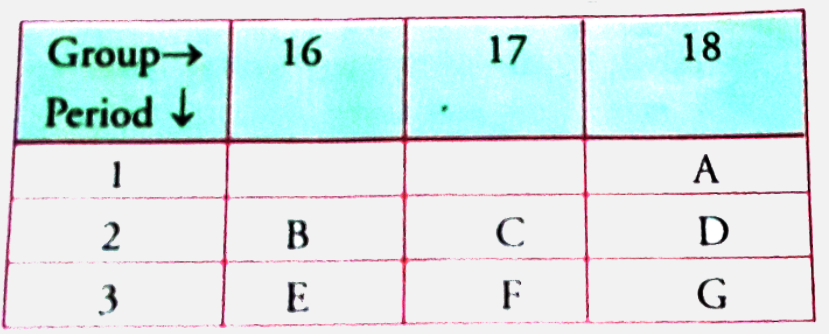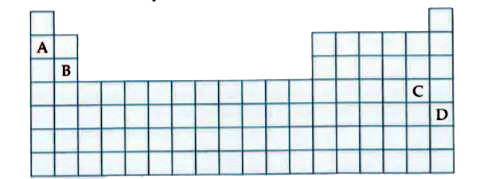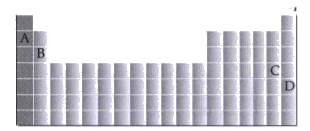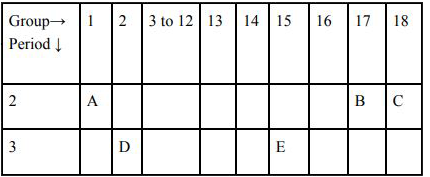The position of some elements A, B, C, D, E, F and G in the Modern Periodic Table is given as under:

(a) In which group are inert elements placed? (b) What type of ions would B, C, E and F form? (c) Which elements would have chemical properties similar to C? (d) How many shells would A have? (e) What is the similarity between A and D? (f) Identify the most abundant element in the earth's crust.
Step by step video & image solution for The position of some elements A, B, C, D, E, F and G in the Modern Periodic Table is given as under: (a) In which group are inert elements placed? (b) What type of ions would B, C, E and F form? (c) Which elements would have chemical properties similar to C? (d) How many shells would A have? (e) What is the similarity between A and D? (f) Identify the most abundant element in the earth's crust. by Chemistry experts to help you in doubts & scoring excellent marks in Class 10 exams.
Updated on:21/07/2023Topper's Solved these Questions
- PERIODIC CLASSIFICATION OF ELEMENTS BOOK - VK GLOBAL PUBLICATIONCHAPTER - PERIODIC CLASSIFICATION OF ELEMENTS EXERCISE - PROFICIENCY EXERCISE (SHORT ANSWER QUESTIONS-II)
5 Videos
- MODEL QUESTIONS PAPER - 5BOOK - VK GLOBAL PUBLICATIONCHAPTER - MODEL QUESTIONS PAPER - 5EXERCISE - SECTION B
3 Videos
- PRACTICAL BASED QUESTIONSBOOK - VK GLOBAL PUBLICATIONCHAPTER - PRACTICAL BASED QUESTIONSEXERCISE - Experiment 15
4 Videos
Similar Questions
The position of some elements A, B, C, D, E, F, and G in the Modern Periodic Table is given as under.

(a) In which group are inert elements placed ?
(b) What type of ions would B, C, E, and F form ?
(c) Which element would have chemical properties similar to C ?
(d) How many shells can A have ?
(e) What is the similarity between A and D ?
(f) Identify the most abundant element in the earth's crust.
View SolutionThe position of three elements A, B and C in the Periodic table are shown below :

Which type of ion, cation or anion, will be formed by element A?
View Solution
Knowledge Check
The positions of four elements A, B, C and D in the Modern Periodic Table are shown below. Which element is most likely to form an acidic oxide ?
 AABBCCDD
AABBCCDDIn the modern periodic table, which group elements have a complete outer shell ?
A15thB18thC16thD17thIn the modern periodic table, which group elements have a complete outer shell?
A15thB18thC16thD17th
The positions of four elements A, B, C and D in the modern periodic table are shown below. Which element is most likely to form an acidic oxide?

View SolutionThe following table shows the position of five elements A, B, C, D and E in the modern periodic table.

Answer the following giving reasons:
(i) Which element is a metal with valency two?
(ii) Which element is least reactive?
(iii) Out of D and E which element has a smaller atomic radius?
View SolutionThe following table shows the position of six elements A, B, C, D, E and F in the period table.

Using the above table answer the following questions :
(a) Which element will form only covalent compounds ?
(b) Which element is a metal with valency 2 ?
(c) Which element is a non-metal with valency of 3 ?
(d) Out of D and E, which one has more atomic radius and why?
(e) Write a common name for the family of elements C and F.
View SolutionThe following table shows the position of six elements A, B, C, D, E and F in the Periodic Table.

Using the above table answer the following questions: (a) Which element will form only covalent compounds? (b) Which element is a metal with valency 2? (c) Which element is a non-metal with valency 3? (d) Write a common name for the family of elements C and F. (e) Out of D and E, which one has a bigger atomic radius and why?
View SolutionThe atomic numbers of elements A, B, C, D and E are given below :

From the above table, answer the following questions -
(a) Which two elements are chemically similar ? (b) Which is an inert gas ?
(c) Which element belongs to 3rd period of periodic table ? (d) Which element among these is a non-metal ?
View Solution
